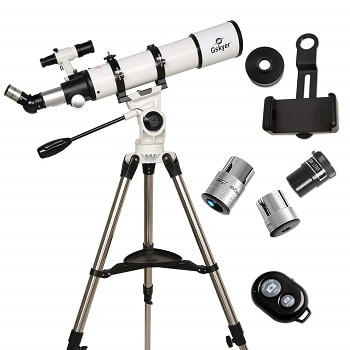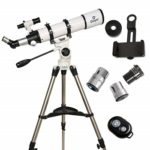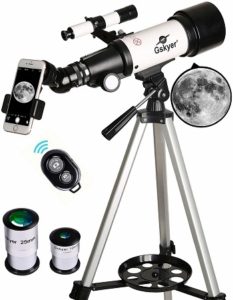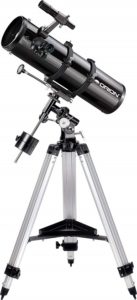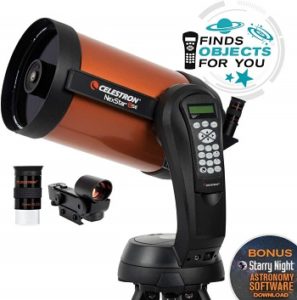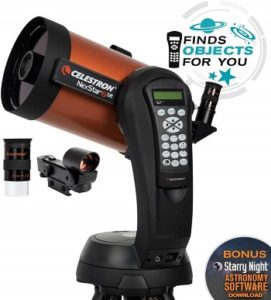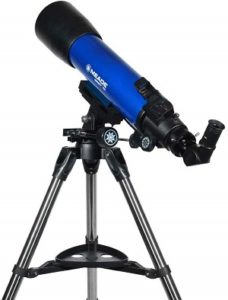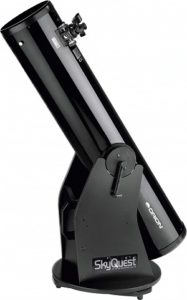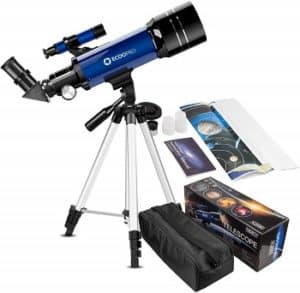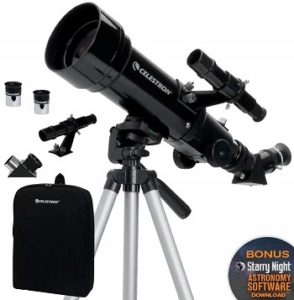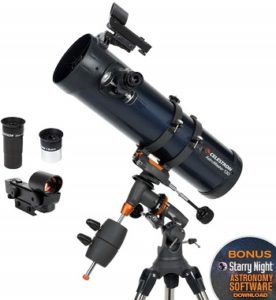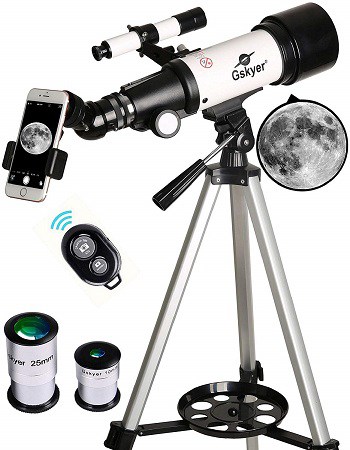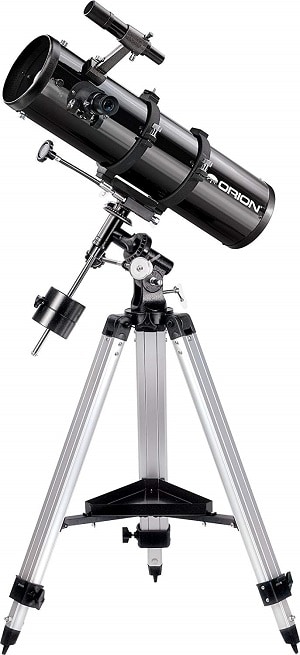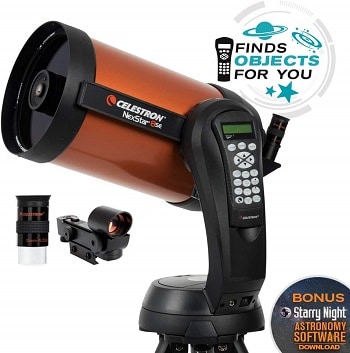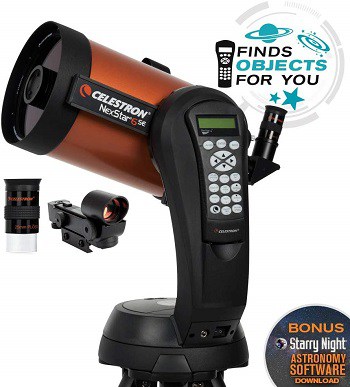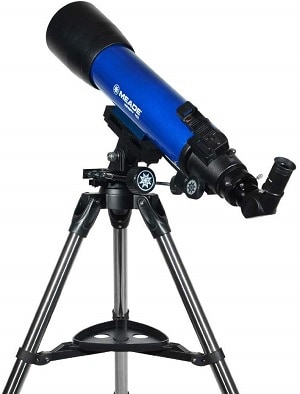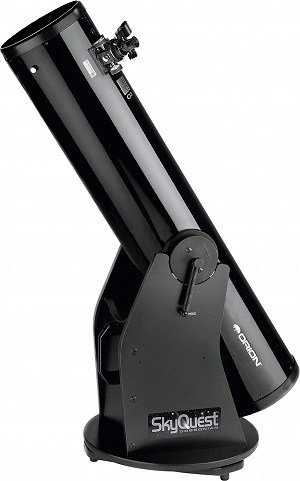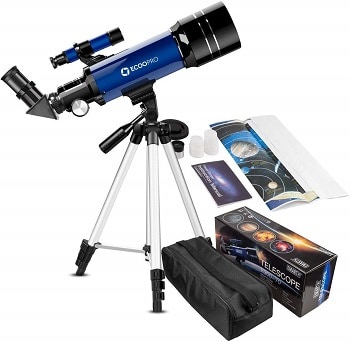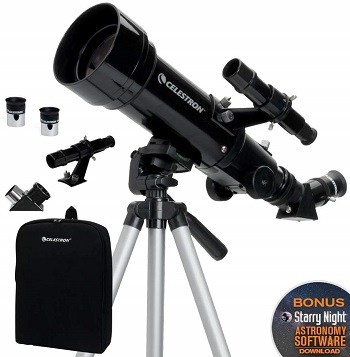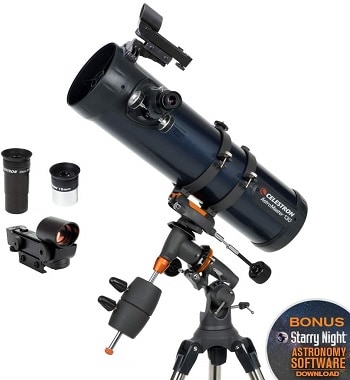This is an exciting time to be alive if you have an interest in celestial objects. From interstellar objects visiting our solar system to astronomers winning the Nobel Prize for their discovery of exoplanets, history is being made on many fronts in astronomy.
With a relatively inexpensive telescope, anyone can indulge in some amateur astronomy and with a few simple add-ons, indulge in some astrophotography as well. Before you point your telescope at Jupiter’s moons or the rings of Saturn, you will need to learn the basics of buying the best telescopes for beginners and how to choose the best telescopes for viewing planets or for your particular viewing interests or astrophotography purposes.
We offer you a guide here on how to buy the best amateur and professional telescopes in 2019.
Luckily, there is no dearth of options when it comes to telescope buying options for amateur astronomers and astrophotography enthusiasts.
Our Overall #1 Rated Pick
Gskyer is one of the most famous brands in the telescope range. It is German made working in the last two decades. The beginners can ideally use this scope to intermediate-advanced level. Anybody can learn the knowledge about the stars and planets easily with the help of this scope. It is very durable as its optical tube features an aluminum alloy.
It provides us incredible optical power and image erect prism so that you can use it easily. With the tube ring, you can enhance its mounting. A stainless-steel tripod and an altazimuth mount make it easy to use when you need to improve its focus. You can view the surface of the moon, moons of Jupiter and the rings of Saturn with clarity.
The 10 Best Telescopes Comparison Chart
Image | Product Name | Ranking | Price |
|---|---|---|---|
1 4.30 | |||
2 4.30 | |||
3 4.30 | |||
4 4.10 | |||
5 4.10 | |||
6 3.80 | |||
7 4.40 | |||
8 4.40 | |||
9 4.00 | |||
10 3.90 |
The 10 Best Telescopes Out There
In this section, we review the Top 10 telescopes available for amateurs and professions.
Gskyer is one of the most famous brands in the telescope range. It is German made working in the last two decades. The beginners can ideally use this scope to intermediate-advanced level. Anybody can learn the knowledge about the stars and planets easily with the help of this scope. It is very durable as its optical tube features an aluminum alloy.
It provides us incredible optical power and image erect prism so that you can use it easily. With the tube ring, you can enhance its mounting. A stainless-steel tripod and an altazimuth mount make it easy to use when you need to improve its focus. You can view the surface of the moon, moons of Jupiter and the rings of Saturn with clarity.
PROS
CONS
Gskyer Telescope is the best telescope with 70mm aperture and focal length to provide the best sky exploring the experience with clarity. To focus on high magnification, it is high transmission coatings of fully coated optical glass so that you can have the high-resolution images with brightness and clarity. You can increase your viewing power with a 3x Barlow lens of interchangeable eyepieces.
It is easy to install, and you can set it up quickly. Even your kids can easily use it and enjoy learning about space. It is the best birthday or holiday gift for children who love astronomy and sentience.
With two bigger focus eyepieces, an erect-image diagonal, and a 5x24 finderscope with a mounting bracket, you can focus and search your image easily.
PROS
CONS
The Orion 09007 SpaceProbe 130ST reflector telescope has a 5.1-inch aperture, which will gather ‘ample’ quantity of light for viewing solar system planets as well as some of the brighter galaxies, star clusters, and nebulas.
Its optical tube design (24-inch long) makes for a highly portable reflector which can be easily transported – it weights a reasonable 27 lbs too -- on summer night astronomy trips and it comes with lots of optional extras including eyepieces, Barlow Lens, Moon Filter and Telescope Accessory Kit including finder scope, tripod accessory tray, rack and pinion focuser, and collimation cap.
It comes with a sturdy EQ-2 equatorial mount making it perfect for deep-sky observations, and the focal ratio (f/5) gives an enjoyable wide-field performance.
PROS
CONS
This Celestron NexStar 8SE is the Big One — it has the biggest aperture among the telescopes reviewed here as well as being the most capable and most expensive.
This versatile Schmidt-Cassegrain telescope with an eight-inch aperture and 81X magnification will appeal to both beginners and advanced telescope aficionados who can use it to view solar system planets as well as capture digital images of some Messier objects.
The automated GoTo mount with a database of 40,000 objects and a SkyAlign feature is especially useful for beginner-level users. You receive free accessories, including a finder scope and eyepiece.
If you want to see the Cassini Division in Saturn’s rings or Jupiter’s Great Red Spot with your own eyes, this Big Boy will help you accomplish that. The Celestron NexStar 8SE has smaller 6-inch and 4-inch siblings are available at lower price points.
PROS
CONS
The Celestron NexStar 6SE is a Schmidt-Cassegrain telescope, which is the high-quality component and quality from each refractor and reflector telescopes. The Celestron NexStar telescope is one of the most up-to-date compound telescopes within the Celestron range, comes with highly optimized a computerized system and StarBright XLT lens coatings to make stars and planets in the line up without any issue. Due to its compact telescope, you can easily transport it to any place.
The 6-inch aperture and 25mm Plossl eyepiece give you n powerful magnification of 60x to 459x level of magnification. This telescope ranks highly exceptional in comparison to others of the same range in terms of tech used in it. The software of this telescope has a 40,000-object database.
PROS
CONS
The Meade Instruments Infinity 102mm AZ Refractor telescope has a four-inch aperture with a focal length of 600 mm and a focal ratio of f/5.9. The telescope comes with low, medium, and high magnification eyepieces a 2X Barlow lens to double the magnification of the eyepiece.
It has a red dot viewfinder to help you point your telescope and also includes astronomical software and an instructional DVD.
This is a refractor type telescope with an Alt-azimuth mount. While the telescope is good for beginner telescope users, it will not work as well for deep-sky observations or long duration tracking of objects for astrophotography.
PROS
CONS
The Orion 8945 SkyQuest XT8 is no doubt will be the best choice for you. It lets astronomers see with its modern-day clarity and its value for your money. This model is a top of the best brand with price and significance.
You can view the faraway galaxies such as the Orion nebulae with Orion 8945 SkyQuest XT8 telescope. You can also get some of the most incredible images of the night sky in your affordable money. It is among the higher range of reflector telescopes, and you will see a superb balance among expenses, clarity, and convenience. It is suitable for every type of stargazer; even the newcomers can also use it easily as well as enthusiasts and professionals.
The optical tube and easy-to-use finder let you view the most extra-terrestrial objects, for example like star clusters and even obscure matter, including nebulae.
PROS
CONS
CSSEA Astronomical telescope is the best telescope for kids and adults. You can provide them the best gift to educate them to explore the world, life, and nature. This 360x70mm refractor Astronomy adjustable telescope can be an excellent observation of terrestrial objects as well as the moon. You do not need any tool to set. So, you can set up very quickly to find your objects. It is the best telescope for kids and beginners to discover significant sky all other objects like planets, moons, fog, clusters. You can also enjoy the natural object fount on long-distance of the earth like plants, birds, wild animals, and mountains.
It is so small that you can carry it anywhere without any problem. It is a very low-cost telescope that will amaze you when you will purchase it. Close us of the moon are clear with it.
PROS
CONS
The Celestron 70mm Travel Scope is the best, portable easy to use telescope comes with many advanced features. It is a brilliant piece for children, beginners, and intermediate astronomers who want to improve their talent to explore the sky. This telescope comes with a 2.76-inch aperture, and a 70mm refractor.it also includes two eyepieces of 10mm, 20mm, giving a magnification of 20x and 40x.
This scope comes with detailed instructions, full-color, The Sky X software so that you can explore the world, planets, and stars. With this software, there are printable sky maps, a 10,000-object database, and 75 improved images. Due to all these features, you will be able to use this telescope professional to improve your knowledge of astronomy. The best feature of this scope is its amazing price and portability.
PROS
CONS
The Celestron NexStar 6SE is the smaller cousin with a 6-inch aperture. It has all the computerized bells and whistles like its 8SE version. It gathers enough light with its primary mirror to make all the objects of the solar system accessible for telescopic observations.
The telescope has a greater ability to gather enough light so that you can view the planets or celestial objects. The installation and deployment of this scope take a couple of minutes. It comes with a high magnification factor and a unique red finder. Its compact form factor makes it travel-friendly on family tips to outdoor locations.
This versatile Schmidt-Cassegrain telescope also comes with the automated GoTo mount with a database of 40,000 objects and a SkyAlign feature. You can easily learn how to explore and how to align for clear views.
PROS
CONS
Different Parts of a Telescope
Here are the different parts of a telescope that you need to know about.
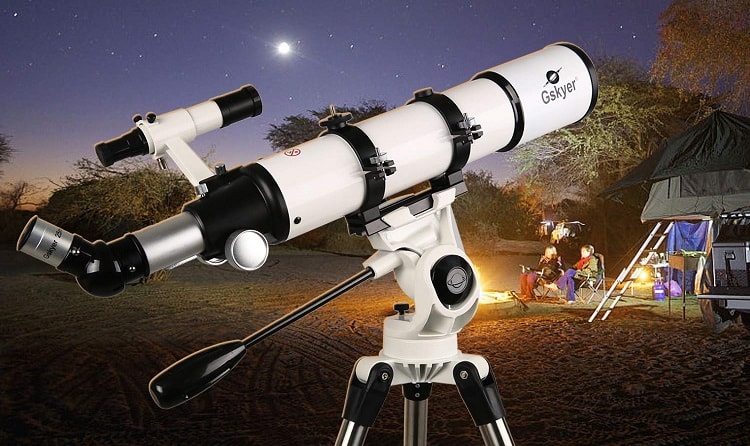
Lens/Mirror
Depending on whether it is a refracting or reflecting telescope, the primary light-gathering part of a telescope is its primary mirror or lens — the bigger the lens or mirror of the telescope. Therefore, bigger is better when it comes to the lens or mirror size of a telescope.
While consumer telescopes can be either reflecting or refracting, the true scientific or astronomical telescopes used by scientists are always reflecting telescopes, whether it’s the Hubble Space Telescope or the Keck Observatories. Mirrors are amenable to precision manufacturing and can have smoother surfaces than lenses. Lenses also bend the light of different wavelengths differently, introducing complications in focusing the final image.
Eyepiece Holder & Focuser
The eyepiece holder holds the eyepiece and they are available in three sizes — 0.965 inches (2.45 cm), 1.25 inches (3.18 cm), and 2 inches (5.08 cm) in diameter. The focuser moves the eyepiece holder and adjusts the focus of the eyepiece.
Telescope Mounts
Whether you treat the telescope mount as part of the telescope or an accessory, you need a good telescope mount if you are looking for the best telescope for viewing planets. The telescope mount carries the weight of the telescope and keeps the telescope pointed in the right direction. If you are observing a deep-sky object for a longer duration or doing astrophotography, which will require keeping the telescope pointed at an object for hours, the telescope mount will the telescope pointed at the right object as the Earth rotates underneath.
A ‘stable’ telescope mount is one that will not keep vibrating for more than a second if you tap the telescope tube. The telescope’s view should stay stable instead of wiggling when you are focusing the telescope with the focus knob. And the telescope’s focus must not change when you let go of the focus knob.
There are primarily two types of telescope mounts: altitude-azimuth and equatorial.
An alt-az telescope mount can move the telescope up-or-down (‘alt’) and left-or-right (‘az’). Equatorial mounts also move the telescope in two axes, one of which is aligned with the rotational axis of Earth.
Small telescopes with alt-az mounts are a simple affair and can make for a great combo if you are looking for the best telescope for beginners. Good quality alt-az mounts will have finely threaded slow-motion controls so that the scope can be moved smoothly in tiny increments. These refinements become useful when you are viewing a planet or the Moon at high magnifications.
Equatorial mounts are essential if you are considering buying the best professional telescope. A telescope with an equatorial mount will be needed for deep-sky astronomy and astrophotography. When you need to track a single astronomical object for long durations, a telescope with an equatorial mount is the best option since you will only need to adjust the scope along one axis only.
Telescopes with alt-az mounts are preferable for casual observers – especially Dobsonians. Equatorial mounts are almost mandatory for astrophotography and high magnification observations of the Moon or Jupiter or Saturn and so on. You will need to learn polar alignment which is to have the scope’s polar axis aligned with the rotational axis of Earth.
Finders
Telescope finders help you find objects in the sky. They are useful when you are using the scope under high magnification.
A common type of finder is a miniature telescope attached near the eyepiece of the main telescope. The finder has low magnification and, therefore, a wide field of view. Finders come equipped with crosshairs. When the finder is aligned with the main telescope, when you center a celestial object in the finder’s crosshairs, you’ll also get the object in the main scope’s view.
Optical finders and reflex sights are types of finders that help you focus your scope on your target. Reflex sights project a point of light on the sky.
What to Consider Before Buying a Telescope?
A telescope is chosen based on several factors: aperture, magnification, telescope mount, portability, price, and so on.
If you are planning to buy a telescope and use it to do some astronomical observations of the Moon, our solar system planets, and even beyond, then you have to give some thought to your typical observing locations. Do you have easy access to a dark spot away from the light-polluted night skies of large cities? You are not going to be able to observe faint galaxies from your suburban backyard observatories.
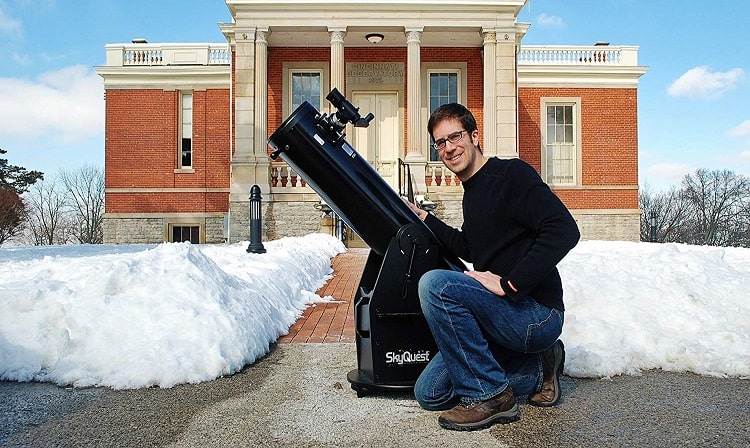
Aperture
As to the technical specs of the telescope itself, the aperture is everything as it determines the telescope’s light-gathering ability – an 8-inch telescope will typically be able to observe a lunar crater that is half as large as a lunar crater visible to a 4-inch telescope. Also, the 8-inch will also gather four times as much light as the 4-inches. Hence, if you are observing a faint galaxy, with the larger scope, your target will be four times brighter.
But before you splurge on a telescope with a really large aperture – and ‘larger’ usually means more expensive when it comes to telescopes – you should give some thought to how much storage space you have and how you are planning to transport your large telescope to distant locations in case your suburban residential location is not ideal for deep sky observing.
Magnification
Be aware that raw magnification is not everything. It’s no good to excessively magnify the image created by a telescope’s primary mirror or lens as that will merely turn a dim object dimmer and a bright object blurry. It’s like how if you magnify a digital image too much, you’ll see the pixels in it.
Telescope Size
Bigger may not always be better if your telescope is so large that it’s difficult for you to carry it from your basement to your terrace by yourself. If your telescope sits somewhere because it doesn’t fit inside your car, then it isn’t of much use. Better to buy a smaller scope that’ll accompany you everywhere.
It also depends on what is it that you want to observe primarily. If you are planning to do deep sky observations of galaxies, nebulae, eclipsing binaries, and so on, then a larger size will help you collect more light from faint objects. If, however, you are planning to look at the Moon or solar system planets, then atmospheric turbulence will prevent you from stretching your scope’s magnifying abilities to their limits. Hence, smaller scopes are just fine for that.
Telescope Types
Refracting Telescopes
A refracting telescope has a large lens at the front which collects and focuses the light, and you look at that image through a smaller lens called an eyepiece.
Refracting telescopes stay in shape more easily and are therefore less cumbersome, requiring less careful handling. Refractors are best for lunar and planetary observations.
On the negative side, the large lenses require careful manufacturing making the scopes expensive. Refractors are not suited for deep-sky observations, and they tend to be heavier. Refractors are also very long, and if the eyepiece is to be at a reasonable height while observing directly overhead objects, you need a tall and sturdy tripod.
Reflecting Telescopes
Reflecting telescopes use a large concave mirror to gather and focus the light from celestial bodies or distant galaxies. All the great observatories of the world house huge reflecting telescopes that professional astronomers use.
One common type of reflecting telescope is the Newtonian reflector – invented by the great Sir Isaac Newton – which has the primary mirror near the bottom of the telescope tube. The eyepiece of this type of telescope is on the side.
Reflecting telescopes of the Newtonian type also have a low center of gravity, which makes for a compact mount, which is relatively inexpensive.
Some of the disadvantages of reflecting telescopes include their need for maintenance, including the need for periodic collimation (or adjustment). Reflectors will also require occasional cleaning since dirt may accumulate on the open optical surfaces of the scope.
Compound Telescopes (Schmidt-Cassegrain Telescopes)
Compound telescopes are a recent invention from the 1930s, and they are designed to combine the best of both telescope types – refractors and reflectors. These mirror-and-lens combos are usually very compact in their usual forms, such as the Schmidt-Cassegrain and Maksutov-Cassegrain.
With their ‘optical folding’ capability, these scopes are only two to three times in length compared to their width. This makes for a lighter mounting. For amateur astronomers, this means a highly portable large-aperture telescope with a long focal length.
Compound telescopes have a sealed tube making them dust-free even when you take them with you for summer night observing trips. But you’ll need to make sure the corrector plate is free from dew with a collar or extension.
With all the technological accessories such as software which integrates the telescope with your smartphone and lets you control the telescope simply by pointing your smartphone at a location or an object in the sky, compound telescopes are pretty user-friendly for beginner users.
These can also be used for astrophotography. So, compound telescopes are strong contenders to be the best professional telescope option.
How to Use a Telescope?
One important bit of advice for beginner users of the telescope is not to have unrealistic expectations. You might have seen those Hubble images of the Orion Nebula online or the dazzling Andromeda galaxy and similar top Hubble images, but those were the result of the efforts of several thousand professionals using a multi-billion dollar space telescope.
And most astronomy images are ‘enhanced.’ Even Cassini’s images of Saturn or Juno’s images of Jupiter are manipulated to increase the contrast.
So, to use a telescope, you need to be in a dark place that should not be too cold. There should not be tall buildings or ambient light around.
You should stay clear of buildings as they emit heat at night, which can blur your target by increasing the turbulence in the atmosphere.
You need to adjust your eyes to the darkness for best viewing results, and this can take up to 30 minutes. Using ‘averted vision’ is one trick you need to learn to observe distant objects. When you try observing from the corner of your eye, you will be able to detect faint objects more easily than by trying to look at them directly.
Maintain your telescope well by covering its lens with a cap when it is not in use. Dust and dew are enemies of astronomical observations.
Never touch the lens or mirror inside the telescope and keep extra eyepieces in a plastic container.
Camel hair brushes are the best options to clean your telescope lens. If you happen to spill anything on to the lens, use special solutions to clean the lens.
FAQs
What Type of Telescope Should I Buy?
It depends. What is your location? What sort of observations do you want to do? Do you want to observe the Moon and the solar system planets or are you more fascinated by galaxies and nebulae? Refractor type telescopes will be better bets for lunar and planetary observations, while reflectors are the best options for deep-sky astronomy. Compound telescopes try to combine the best of both worlds.
So, make your choice depending upon whether you are looking for the best telescopes for beginners or the best telescopes for viewing planets or the best professional telescopes.
How Big Should My Telescope Be?
Bigger may be better when it comes to telescopes. Bigger the aperture, more the amount of light collected by the telescope, which leads to a better image. You should also bear the mind the weight of the telescope, how large it is, how portable it is, how much space you have for storage, and so on.
How Powerful Should My Telescope Be?
Novice telescope buyers are probably most likely to be misguided by this factor. Telescope sellers may hype “200x” or “400x” magnification of their telescopes. However, magnification or power is not what you want to be looking at in judging or evaluating a telescope for purchase.
Since almost any level of magnification can be achieved by using the required eyepiece, aperture is the more accurate measure of a telescope’s capability.
What is the Right Telescope for Kids?
Telescopes with a 4” aperture would be good enough for kid’s purposes. When considering what telescopes to buy for kids, remember that the telescopes should be lightweight. The telescope mount has to be kid-friendly so that kids can see through the eyepiece. The mounts should be sturdy and stable so that the telescope doesn’t vibrate while observing.
Your first telescope for your kid can be a basic one. As they grow older, they can graduate to bigger ones. Remember that many well-known got interested in the wonders of astronomy via a telescope that they got as a birthday present when they were a kid – Carl Sagan and Neil deGrasse Tyson come to mind as two examples immediately.
Final Words
While modern-day telescopes are improving in terms of the electronic accessories they have, the basic purpose of telescopes has changed very little since Galileo first observed the Galilean moons of Jupiter in 1610.
So, while considering what is the best professional telescope or the best telescope for viewing planets, you can keep things simple by focusing on the telescopes design – whether it’s a reflector-type telescope or a reflector-type telescope or a combination design like a Schmidt-Cassegrain telescope which combines the best of both designs — and aperture.
The focal length, focal ratio and user experience aspects (weight, telescope mount and so on) are the next things to keep in mind. We suggest you to go through each all details, specification and read all the pros and cons thoroughly before selecting any brand.

